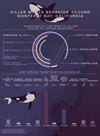A distinct subpopulation of orca whales appears to be using specialized hunting techniques to hunt the marine mammals that they eat. Orca–or killer whales–are the ultimate apex predators, who have been observed attacking great white sharks, porpoises, and even blue whales. They are found in every ocean on the planet, and the specific environments that they live in have largely shaped their particular food preferences. The killer whales that forage near the deep submarine canyons off the California coast may use the sloping seascape to inform the ways that they catch food. These findings are described in a study published March 20 in the open-access journal PLOS ONE.
Residents vs. transients
Groups of orca whales can form different populations or ecotypes. They have their own social structures, food preferences, and hunting techniques. Resident killer whales, like the three endangered pods that spend the summer and fall months in and around Puget Sound near Seattle, Washington exclusively eat salmon and have a more round dorsal fin.
[Related: Orca observed hunting and killing a great white shark by itself for the first time.]
The other type of killer whales called transient killer whales specialize in hunting marine mammals. Transients are typically slightly larger than resident orcas have a more pointed dorsal fin.
The transients that forage in the Northern Pacific Ocean can also be further divided into two groups. The inner coast whales feed in shallow coastal waters, while outer coast whales hunt in deeper water. Most studies have focused on the orcas that hunt closer to shore and not much is known about the foraging techniques for the more offshore whales, such as those near the Monterey Submarine Canyon in California.
“Monterey Bay provides a conducive environment to investigate transient foraging ecology and behavior, due to it having a large deep submarine canyon system occurring close to shore that is accessible to researchers,” study co-author and University of British Columbia marine ecologist Josh McInnes tells PopSci.
Two distinct foraging behaviors
McInnes and his team looked at the outer coast transient killer whales that foreage around the undersea Monterey Canyon, which is one of the deepest in the United States. They compiled and analyzed data from marine mammal surveys conducted between 2006 and 2018 and whale-watching ecotours between 2014 and 2021. The whales mainly ate California sea lions, gray whale calves, and northern elephant seals.
The orcas were observed using two different foraging behaviors that appear to be unique to these more offshore transients. When foraging open water, the groups spread out and searched independently for marine mammals to eat. Each whale would also surface at a different time.
 Researchers observed how transient killer whales in Monterey Bay, California spent their time through 270 hours of behavioral observations. Foraging accounted for 84.16 percent of the time spent by orcas, with other activities including traveling, socializing and resting. Additionally, this study presents the main targeted prey species: mostly California sea lions, and gray whale calves. The findings provide insights into predator-prey interactions in this submarine canyon/deep-water environment. CREDIT: Anne-Lise Paris, (www.in-graphidi.com), PLOS, CC-BY 4.0
Researchers observed how transient killer whales in Monterey Bay, California spent their time through 270 hours of behavioral observations. Foraging accounted for 84.16 percent of the time spent by orcas, with other activities including traveling, socializing and resting. Additionally, this study presents the main targeted prey species: mostly California sea lions, and gray whale calves. The findings provide insights into predator-prey interactions in this submarine canyon/deep-water environment. CREDIT: Anne-Lise Paris, (www.in-graphidi.com), PLOS, CC-BY 4.0
However, if they were looking around the deep submarine canyons and shelf-breaks, groups of whales would search for prey following the contours of the canyon. The group would also surface at the same time.
According to McInnes, both foraging behaviors appear to be unique to these whales from the other transient groups that hunt in shallow water.
[Related: Raising male offspring comes at a high price for orca mothers.]
“Their ability to locate and follow the contours of the canyon was surprising based on our focal follow surveys,” says McInnes. “We hypothesize that transient killer whales hunting in submarine canyons may listen to water being upwelled along the continental slope or shelf-break.”
Ramming or punting sea lions
The orcas also deploy special techniques if their prey couldn’t be easily cornered in open water. They subdued their prey by ramming into them with their head or body–as some orca do to boats. The whales also used their powerful tails to hit or launch sea lions out of the water and into the air.
McInnes and the team believes that these outer coast whales are a distinct subpopulation that has developed these hunting techniques in such a deep water habitat. It’s also possible that these foraging behaviors may be culturally transmitted from one generation to the next. The team was surprised by their affinity for along the slopes of the canyon and shelf-break and just how much time they spent foraging and feeding.
“Transient killer whales in Monterey Bay, California spend 84 percent of daylight hours foraging (searching, pursuing, and feeding), which is a significant amount of time,” says McInnes. “Feeding appears to be related to the size of prey these whales tackle, with long hunts involving gray whale calves and California sea lions.”
McInness also said the team “really appreciate” any photographs or sightings of killer whales. Images of killer whales can be sent to [email protected].

>>> Read full article>>>
Copyright for syndicated content belongs to the linked Source : Popular Science – https://www.popsci.com/environment/orca-hunting-techniques/































